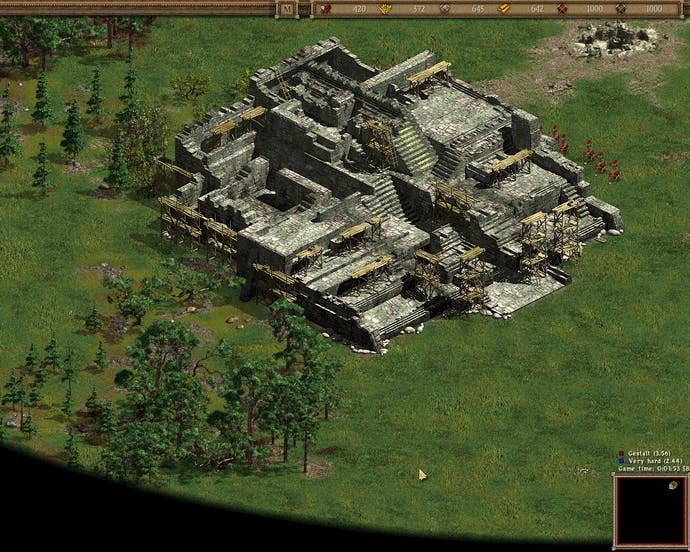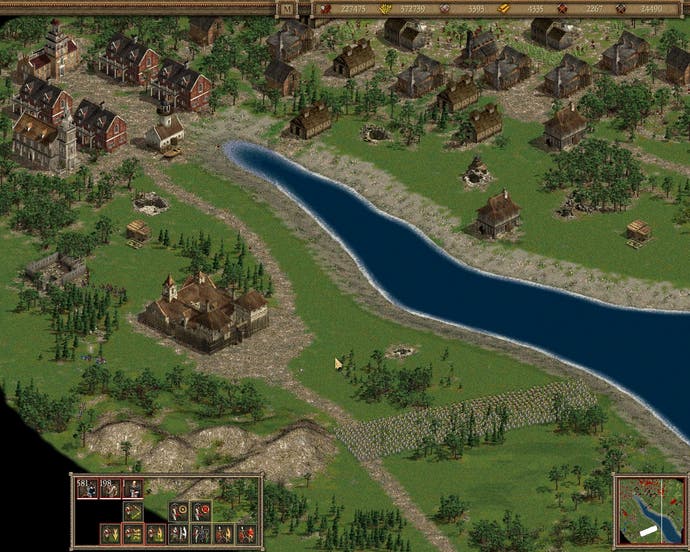American Conquest review
Hands On - Cossacks' developers conquer the New World in their real-time strategy follow-up
It's no great secret that Cossacks is one of my favourite real-time strategy games of recent years. With epic battles that can feature literally thousands of troops on-screen at once, superb multiplayer support and a variety of historical single player campaigns following more than a dozen European nations through two centuries of conflict, it was a truly spectacular affair.
And judging from the preview code we've been playing for the last few weeks, American Conquest is bigger and better in almost every regard.

Brave New World
Hand-crafted by Cossacks developer GSC Game World and based upon an updated version of the engine that powered their original real-time strategy hit, American Conquest is to all intents and purposes Cossacks 1.5, a stopgap to keep fans of the series occupied until the arrival of the Napoleonic Wars themed sequel.
American Conquest is no half-hearted cash-in though, covering some three centuries of warfare in the New World from the establishment of the first colonies by Christopher Columbus to the War Of Independence and beyond. Many of the battles can be fought from both sides, giving you the chance to desperately fight off the conquistadors as an Aztec general, or to control the British as they try to contain those pesky American revolutionaries. Less well known wars are also included, such as a campaign in which you take on the role of Tecumseh as he works to establish a native alliance to halt the westwards expansion of the newly formed United States of America. The game is a far cry from the all-American "manifest destiny" tubthumper you might have expected - missions can vary from leading a rabble of Spanish adventurers as they loot their way through Central America to holding off seemingly endless waves of native warriors as you wait for reinforcements to arrive.
Battles are more impressive than ever, with the game allowing a frankly ludicrous 16,000 units to run around the map at once. The roar of gunfire and hollering of native warriors charging into a fight is deafening, and it's hardly surprising that in the early stages of the game at least the natives are terrified of the din made by horses and firearms. Morale plays a much bigger role than in Cossacks, and native troops will often break down and run away in the midst of a battle when they get panicked. Playing as the European invaders is still far from easy though - native troops may have little or no armour but they tend to move faster as a result, and if you're not careful you can find your heavily laden pikemen being constantly harried by archers who run off before you can reach them, slipping away through the jungle as you approach.

Fort Apache
This attention to detail is found throughout the game, and gives each side in the conflict its own unique flavour. Whereas in Cossacks most countries were essentially the same, in American Conquest the troops, technologies, buildings and gameplay vary drastically from one nation to the next. So while the Incas and Aztecs are frightened by horses and gunfire, the Sioux fighting on the great plains a century or two later are quite comfortable using these weapons themselves. The natives aren't your stereotypical "noble savages" either; some tribes do live in wigwams and hunt buffalo for food, but others build wooden houses and cultivate crops.
The graphics are more detailed and varied as well, and the world of American Conquest is an endless source of wonder. Maps can stretch for literally miles in every direction, which makes the new zoom mode a particularly welcome addition, allowing you to get a wider view of the battlefield. Streams and rivers flow through dense jungle towards the sea where waves lap against the shoreline, and naturally this landscape is dotted with ornate buildings varying from vast stepped pyramids to the brick houses and stone forts of the colonists.
The buildings aren't just there to look pretty or to increase your population limit either; units can now be stationed inside any of your buildings, making the cavalry raids that were so common in Cossacks a little less devastating. If you're quick you can now bundle any stray peasants into nearby buildings to stop them from being captured, and once safely inside your men will start firing out the windows at their attackers. As a result battles over towns tend to descend into lethal street-to-street fighting as you rush into buildings to root out their hidden defenders. Casualties can be horrendously high, and warfare in American Conquest is generally a frantic, brutal and noisy affair.
Conclusion
Although there were some missing features in the build we played (most notably artillery, ships and multiplayer support), American Conquest is already a lot of fun to play and has proved more entertaining than any other real-time strategy game I've played since the original Cossacks. It's shaping up to be another monster hit for Ukrainian developer GSC Game World, and I for one can't wait to see the finished product.

